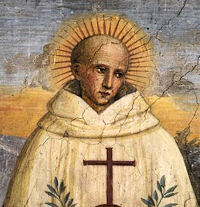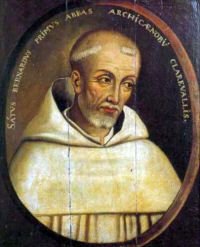Move to: Previous day | Next day
Memorial Day of St. Bernard, Abbot and Doctor of the Church
Further commemorations: St. Bernard Tolomei, Abbot (RM)
» Enjoy our e-book series “Liturgical Seasons”!
The church celebrates the Commemoration of Saint Bernard of Clairvaux (1090-1153) today. Bernard was born near Dijon and died in Clairvaux, France. He came from a noble family and received a careful education in his youth. With his father, his brother and thirty noblemen he entered the Benedictine monastery of Citeaux. Two years later he founded a monastery in Clairvaux with a group of monks and became its abbot. The monastic rule that he perfected in Clairvaux became the model for 163 monasteries of the Cistercian reform. He was a theologian, poet, orator and writer. He is one of the last Fathers of the Church.
The church also commemorates St. Bernhard Tolomei (1272-1348), Founder of the Olivetan Congregation of the Benedictines.
Saint Bernard of Clairvaux
Bernard, the second founder of the Cistercians, the sweet teacher, the apostle of the crusades, the miracle worker, the reconciler of kings, the leader of the peoples, the adviser of the popes! His sermons, many extracts of which can be found in the breviary, are characterized by genuine emotion and spiritual unction. The famous Memory is attributed to him.
Bernard was born in 1090, the third son of a famous Burgundian family. At the age of 22, he entered the monastery of Cîteaux (where the Cistercian Order began) and convinced thirty other young noblemen to follow his example. When he was appointed abbot of Clairvaux in 1115, he built numerous abbeys where his spirit flourished. He dedicated his work to his pupil Bernard of Pisa, later Pope Eugene III. Out of consideration. Bernard’s influence on the princes, the clergy and the people of his time was most remarkable. Through penances he exhausted his body so much that he could hardly nourish his soul, which always strove to praise and honor God.
—Excerpt from The Church’s Year of GracePius Parsch
Patronage: Beekeepers; bees; candle makers; candlestick makers; wax melters; wax refineries; Gibraltar; Queens College, Cambridge; Binangonan, Rizal, Philippines; Cistercian Order; Cistercians; Cîteaux Abbey; Knights Templar; Diocese of Pelplin, Poland; Speyer Cathedral; France: Burgundy, Pontigny; Algeciras, Spain
Symbols and representation: Beehive; bees; three mitres on a book; white dog; inkwell and quill; instruments of the Passion; bound demon; book.
Often depicted as: Cistercian with a vision of Mary; Cistercian with a beehive; Cistercian with a chained demon; Cistercian with a mitre on the ground next to him; Cistercian with a swarm of bees nearby; Cistercian with a white dog; Cistercian writing and observing Mary; with St. Humbling
Highlights and activities:
- Although he came from a wealthy and noble family, Saint Bernard continually asked himself the question, “Why are you on earth?” Spend some time today before the Blessed Sacrament and ask yourself this question.
- Since St. Bernard is the patron saint of candle makers, learning how to make candles would be a great project. Candles 101 briefly explains how to make homemade candles, rolling, dipping, and shaping. By practicing candle making now, you can prepare to make a family Christmas candle for Advent and Christmas and a Paschal candle for Easter.
- Read more about the St. Bernard:
- Read the book by Father M. Raymond Flanagan The Family That Outran Christ: The Story of Saint Bernard of Clairvaux and His Family
- The hymn book contains hymns written by St. Bernard.
- Learn more about the Cistercian Order founded by St. Bernard.
- For featured artworks by Saint Bernard, see Christian Iconography.
- From the Library of Catholic Culture:
- See the statue of Saint Bernard in the colonnade of St. Peter’s Basilica
St. Bernard Tolomei
 Bernardo Tolomei, son of Mino Tolomei, was born in Siena on May 10, 1272. He was given the name Giovanni at his baptism. He was probably educated by the Dominicans at their college of San Domenico di Camporegio in Siena. Rodolfo I d’Absburgo (d. 1291) knighted him. While studying law in his hometown, he was also a member of the Confraternity of the Disciplinati di Santa Maria della Notte, dedicated to nursing the sick at the Hospital della Scala. Due to progressive and almost total blindness, he was forced to give up his public career. In order to pursue a more radical Christian and ascetic ideal, in 1313 he and two companions (Patrizio di Francesco Patrizi, d. 1347, and Ambrogio di Nino Piccolomini, d. 1338), both noble Sienese merchants and members of the same brotherhood, withdrew to Accona, to a family estate about 30 km southeast of the city. Here Giovanni, who had now taken the name Bernardo out of devotion to the holy Cistercian abbot, led a hermit-like penitential life with his two companions, characterized by prayer, manual work and silence.
Bernardo Tolomei, son of Mino Tolomei, was born in Siena on May 10, 1272. He was given the name Giovanni at his baptism. He was probably educated by the Dominicans at their college of San Domenico di Camporegio in Siena. Rodolfo I d’Absburgo (d. 1291) knighted him. While studying law in his hometown, he was also a member of the Confraternity of the Disciplinati di Santa Maria della Notte, dedicated to nursing the sick at the Hospital della Scala. Due to progressive and almost total blindness, he was forced to give up his public career. In order to pursue a more radical Christian and ascetic ideal, in 1313 he and two companions (Patrizio di Francesco Patrizi, d. 1347, and Ambrogio di Nino Piccolomini, d. 1338), both noble Sienese merchants and members of the same brotherhood, withdrew to Accona, to a family estate about 30 km southeast of the city. Here Giovanni, who had now taken the name Bernardo out of devotion to the holy Cistercian abbot, led a hermit-like penitential life with his two companions, characterized by prayer, manual work and silence.
Towards the end of 1318 or the beginning of 1319, while in deep prayer, he saw a ladder climbed by monks in white robes, assisted by angels and awaited by Jesus and Mary.
To secure the legal status of his group, Bernardo, together with Patrizio Patrizi, visited the Bishop of Arezzo, Guido Tarlati di Pietramala (1306-c.1327), under whose jurisdiction Accona then fell. On 26 March 1319 he obtained a decree authorising him to build the future monastery of Santa Maria di Monte Oliveto, and instituted “sub regula sancti Benedicti” with certain privileges and dispensations. Through his legate, the bishop received their monastic vows. Opting for the Rule of St. Benedict, Bernardo accepted Benedictine cenobitism and, to honour Our Lady, the founders wore a white habit. The bishop greeted the small group of monks with the words: “Since your fellow citizens are proud to place themselves under the protection of the Virgin and because of the virginal purity of the glorious Mother, you are pleased to wear a white monk’s habit, thus showing outwardly the purity that you carry within you.” (Antonio di Barga, Cronaca 5). The white habit was characteristic of various forms of medieval monasticism, including the Camaldolese, Carthusians, Cistercians and the monks of Montevergine.
With the laying of the first stone of the church on April 1, 1319, the monastery of Santa Maria di Monte Oliveto Maggiore was born. The hermits became monks according to the Rule of St. Benedict, to which they made some institutional changes. The most characteristic element of this institutional change, recorded in an episcopal document of March 28, 1324, was the provisional nature of the abbot’s office and the elected abbot had to be confirmed by the Bishop of Arezzo. When the time came to elect an abbot, Bernardo managed to withdraw from the electors due to his poor eyesight. Therefore, Patrizio Patrizi was elected first abbot (September 1, 1319). Two other abbots followed: Ambrogio Piccolomini (September 1, 1320) and Simone di Tura (September 1, 1321). On September 1, 1322, Bernardo could no longer oppose the wishes of his brothers and became the fourth abbot of the monastery he had founded, which he held until his death. An act of September 24, 1326 attests that the apostolic legate Cardinal Giovanni Caetani Orsini (†1339) dispensed Abbot Bernardo from the canonical disability of visual impairment, thus confirming his election. From Avignone, with three bulls of January 21, 1344 (Important Vestrae Sanctitati: recognizes the foundation and asks for papal privileges; Holidays under religion: canonical recognition of the new community; Solicitudinis pastoralis officium(the authority to establish new monasteries in Italy) Clement VI approved the congregation, which numbered ten monasteries. Bernardo did not go to Avignone himself, but sent two monks: Simone Tendi and Michele Tani.
An important proof of Bernardo’s spiritual personality is the fact that, although the monks had decided not to re-elect an abbot at the end of his annual mandate, they decided to ignore this and re-elect Bernardo for 27 consecutive years, until his death. Another act of trust in Bernardo’s paternity was the General Chapter of May 4, 1347, when the monks granted him the authority to govern without recourse to the Chapter and the brothers, trusting that he would do everything in accordance with God’s will and for the salvation of all.
Bernardo attempted to resign from the office of abbot at least twice, in 1326 and 1342, by declaring to the legate and the Pope’s jurists that he was not a priest but only in the minor orders, and also invoking the existing dispensation from his function as abbot due to his persistent visual impairment. However, his leadership was declared to be completely legitimate even according to the canonical norms of the time. With the papal approval of a new Benedictine congregation called “Santa Maria di Monte Oliveto”, Bernardo was the initiator of a determined Benedictine monastic movement.
Bernardo left his monks an example of a holy life, the practice of virtues at a heroic level, a life of service to others and of contemplation. During the plague of 1348, Bernardo left the solitude of Monte Oliveto and went to the monastery of San Benedetto a Porta Tufi in Siena. In the city, the disease was particularly bad. On August 20, 1348, while helping his plague-stricken monks, he himself fell ill with the plague along with 82 other monks.
This hero of penance and martyr of charity did not go unnoticed, as Pius XII noted in a letter to Abbot General Dom Romualdo M. Zilianti on April 11, 1948, commemorating the upcoming 600th anniversary of Blessed Bernardo’s death. The venerable abbot was buried near the monastery church in Siena. All the bodies affected by the plague were placed in a common pit of unburnt lime outside the church. Unfortunately, the search for the bodies of the plague victims both in Siena and in and around the Abbey of Monte Oliveto Maggiore has remained unsuccessful to this day.
—Excerpt from the Vatican website
Patronage: Olive growers or farmers; Olivetans; Siena, Italy
Highlights and activities:
- Read more about the St. Bernard:
- Visit the website of the Abbey of Monte Oliveto Maggiore.


